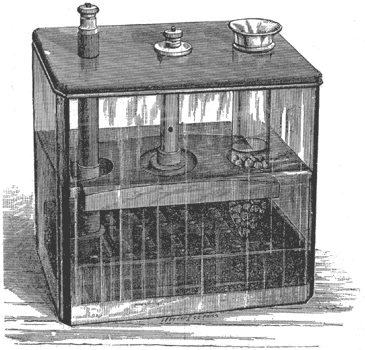[Trade Journal]
Publication: Electrical Review
New York, NY, United States
vol. 8, no. 22, p. 8, col. 2
New Acid Gravity Battery.
The Partz Electric Battery Company, of Philadelphia, are manufacturing the above battery. In this the gravity principle is applied to voltaic apparatus of the Bunsen type in a way similar to that in which it has been applied to apparatus of the Daniell type. When using an ordinary Bunsen or Poggendorff battery, in which carbon cathodes are depolarized by either nitric or chromic acid, one is obliged, in order to obtain its full effect, to supply it with the normal quantity of acid, for however short a time it may be wanted, and unless it be taken apart after having done its work, the liquids, vertically separated by permeable partitions, will soon diffuse and material be wasted. On account of their saving the
 |
| New Acid Gravity Battery of the Partz Electric Co., Phila. |
trouble of removing and emptying the porous clay cups, "dip-batteries" on Grenet's plan, variously modified, have become the favorite means of generating strong electric currents for temporary applications, though the periods of their employment are inconveniently limited by a speedy decrease of power. The Acid Gravity Battery may be supplied with the depolarizing material from time to time according to the work it is designed to do and without interrupting the same. It seldom requires to be emptied and, unless it be left unused for weeks or months, the zincs may remain in the liquid. The E.M F. of a cell is about 1.95. The manufacturers give its strength of current, as follows :
 |
The Acid Gravity Battery has proved of excellent service in its application to electro-magnetic dental mallets, which are satisfactorily operated by four cells. Its efficiency and great convenience render it equally well suited for surgical and dental glow lights, for cautery (from 4 to 6 cells), for electro-plating by jewelers, watchmakers and amateurs, and it is well adapted to the wants of a chemical or physical laboratory.
